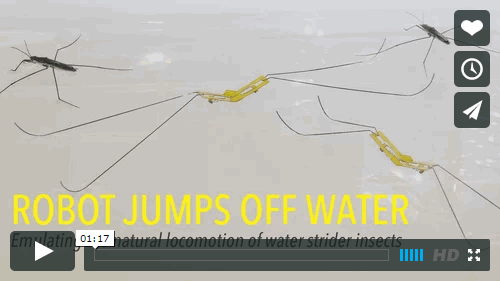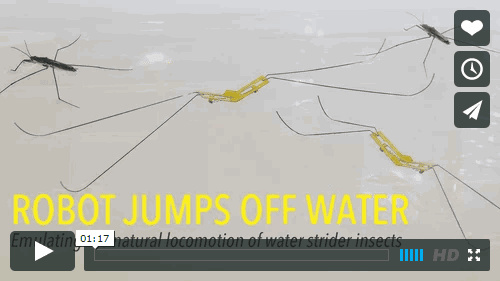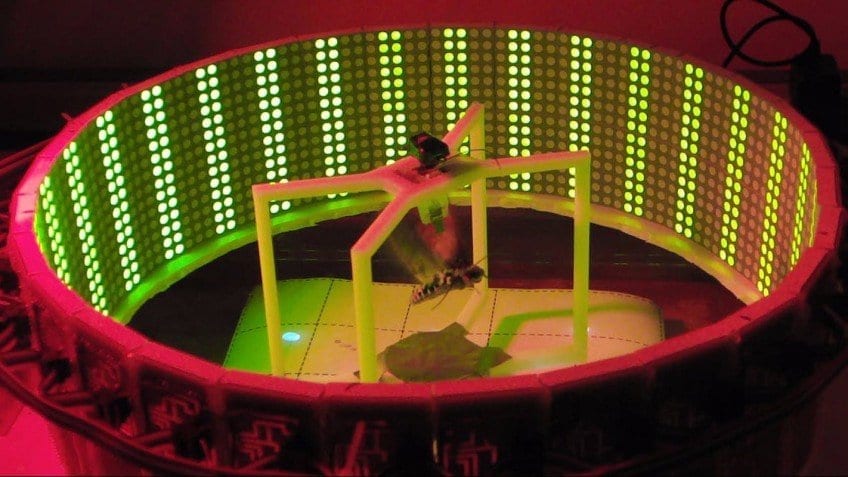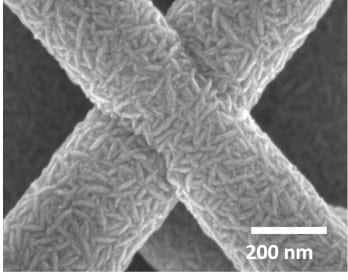
An international team of Seoul National University and Harvard researchers looked to water strider insects to develop robots that jump off water’s surface
The concept of walking on water might sound supernatural, but in fact it is a quite natural phenomenon. Many small living creatures leverage water’s surface tension to maneuver themselves around. One of the most complex maneuvers, jumping on water, is achieved by a species of semi-aquatic insects called water striders that not only skim along water’s surface but also generate enough upward thrust with their legs to launch themselves airborne from it.
Now, emulating this natural form of water-based locomotion, an international team of scientists from Seoul National University, Korea (SNU), Harvard’s Wyss Institute for Biologically Inspired Engineering, and the Harvard John A. Paulson School of Engineering and Applied Sciences, has unveiled a novel robotic insect that can jump off of water’s surface. In doing so, they have revealed new insights into the natural mechanics that allow water striders to jump from rigid ground or fluid water with the same amount of power and height. The work is reported in the July 31 issue of Science.
“Water’s surface needs to be pressed at the right speed for an adequate amount of time, up to a certain depth, in order to achieve jumping,” said the study’s co–senior author Kyu Jin Cho, Associate Professor in the Department of Mechanical and Aerospace Engineering and Director of the Biorobotics Laboratory at Seoul National University. “The water strider is capable of doing all these things flawlessly.”
The water strider, whose legs have slightly curved tips, employs a rotational leg movement to aid it its takeoff from the water’s surface, discovered co–senior author Ho–Young Kim who is Professor in SNU’s Department of Mechanical and Aerospace Engineering and Director of SNU’s Micro Fluid Mechanics Lab. Kim, a former Wyss Institute Visiting Scholar, worked with the study’s co–first author Eunjin Yang, a graduate researcher at SNU’s Micro Fluid Mechanics lab, to collect water striders and take extensive videos of their movements to analyze the mechanics that enable the insects to skim on and jump off water’s surface.
It took the team several trial and error attempts to fully understand the mechanics of the water strider, using robotic prototypes to test and shape their hypotheses.
“If you apply as much force as quickly as possible on water, the limbs will break through the surface and you won’t get anywhere,” said Robert Wood, Ph.D., who is a co–author on the study, a Wyss Institute Core Faculty member, the Charles River Professor of Engineering and Applied Sciences at the Harvard Paulson School, and founder of the Harvard Microrobotics Lab.
But by studying water striders in comparison to iterative prototypes of their robotic insect, the SNU and Harvard team discovered that the best way to jump off of water is to maintain leg contact on the water for as long as possible during the jump motion.
“Using its legs to push down on water, the natural water strider exerts the maximum amount of force just below the threshold that would break the water’s surface,” said the study’s co-first author Je-Sung Koh, Ph.D., who was pursuing his doctoral degree at SNU during the majority of this research and is now a Postdoctoral Fellow at the Wyss Institute and the Harvard Paulson School.
Mimicking these mechanics, the robotic insect built by the team can exert up to 16 times its own body weight on the water’s surface without breaking through, and can do so without complicated controls. Many natural organisms such as the water strider can perform extreme styles of locomotion – such as flying, floating, swimming, or jumping on water – with great ease despite a lack of complex cognitive skills.
Read more: Robotic insect mimics Nature’s extreme moves
The Latest on: Biorobotics
[google_news title=”” keyword=”Biorobotics” num_posts=”10″ blurb_length=”0″ show_thumb=”left”]
via Google News
The Latest on: Biorobotics
- Unveiling 4 Analyst Insights On PROCEPT BioRoboticson May 6, 2024 at 10:19 am
Analysts' evaluations of 12-month price targets offer additional insights, showcasing an average target of $70.0, with a high estimate of $75.00 and a low estimate of $58.00. Witnessing a positive ...
- Analysts Offer Insights on Healthcare Companies: Sanofi (OtherSNYNF) and PROCEPT BioRobotics (PRCT)on May 6, 2024 at 1:51 am
There’s a lot to be optimistic about in the Healthcare sector as 2 analysts just weighed in on Sanofi (SNYNF – Research Report) and ...
- Real-World, Long-Term Data Demonstrate Sustained Benefits of Aquablation Therapy for Men with ...on May 5, 2024 at 10:04 pm
SAN JOSE, Calif., May 06, 2024 (GLOBE NEWSWIRE) -- PROCEPT BioRobotics® Corporation (Nasdaq: PRCT) (the “Company”), a surgical robotics company focused on advancing patient care by developing ...
- PROCEPT BioRobotics Corporation (NASDAQ:PRCT) Just Reported And Analysts Have Been Lifting Their Price Targetson May 4, 2024 at 5:43 am
PROCEPT BioRobotics Corporation (NASDAQ:PRCT) just released its latest quarterly results and things are looking bullish. PROCEPT BioRobotics beat expectations with revenues of US$45m arriving 6.3% ...
- Director Thomas Krummel Sells 20,000 Shares of PROCEPT BioRobotics Corp (PRCT)on May 3, 2024 at 7:58 pm
On May 1, 2024, Thomas Krummel, Director at PROCEPT BioRobotics Corp (NASDAQ:PRCT), sold 20,000 shares of the company. The transaction was filed on the same day with the SEC. Over the past year, the ...
- PROCEPT BioRobotics First Quarter 2024 Earnings: Beats Expectationson May 3, 2024 at 5:26 am
Revenue exceeded analyst estimates by 6.3%. Earnings per share (EPS) also surpassed analyst estimates by 7.3%. Looking ahead, revenue is forecast to grow 24% p.a. on average during the next 3 years, ...
- PRCT Stock Earnings: PROCEPT BioRobotics Beats EPS, Beats Revenue for Q1 2024on May 1, 2024 at 2:53 pm
PRCT stock results show that PROCEPT BioRobotics beat analyst estimates for earnings per share and beat on revenue for the first quarter of 2024.More From InvestorPlace The #1 AI Investment Might Be ...
- Biotech Leader Procept BioRobotics Surges Past Buy Point On Earningson May 1, 2024 at 1:03 pm
Biotech leader Procept BioRobotics is breaking out past its latest buy point. Shares jumped on Q1 earnings results Wednesday.
- PROCEPT BioRobotics Corp PRCTon April 19, 2024 at 6:00 am
Morningstar Quantitative Ratings for Stocks are generated using an algorithm that compares companies that are not under analyst coverage to peer companies that do receive analyst-driven ratings ...
- PROCEPT BioRobotics Stock (NASDAQ:PRCT), Quotes and News Summaryon February 23, 2024 at 6:46 am
Intel, Saia, Charter Communications And Other Big Stocks Moving Higher On Friday U.S. stocks traded higher, with the Dow Jones gaining around 100 points on Friday. Here are some big stocks recordi ...
via Bing News











